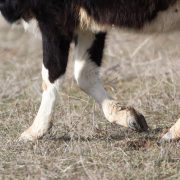Survival of bovine digital dermatitis treponemes on hoof knife blades and the effects of various disinfectants
Survival of bovine digital dermatitis treponemes on hoof knife blades and the effects of various disinfectants

Open Access
In our edition of: Apr 2020
In our categories of: farm animals
our summary:
Gillespie, A. et al. (2020) Survival of bovine digital dermatitis treponemes on hoof knife blades and the effects of various disinfectants. Veterinary Record, 186, p. 67
The aim of this study, funded by BBRSC and AHDB Dairy, was first to test the survival times of treponemes on hoof knife blades under aerobic conditions, and secondly to test a range of common disinfectants at working concentrations for removing viable treponemes from hoof knife blades.
Two strains of Bovine digital dermatitis (BDD) associated treponeme bacteria were used: T320A (Treponema phagedenis-like phylogroup) and T3552B (T pedis). These were diluted to standardised concentrations and 0.5 ml cultures were applied to one side of each hoof blade knife. Swabs were taken from blade surfaces two minutes after application of the cultures and placed into a liquid medium, these acted as positive controls.
For the first study looking at survival, time samples were taken after 10 minutes, one hour, two hours, four hours and 18 hours. One swab was inoculated into a liquid medium and placed in an anaerobic cabinet as soon as possible and the second was stored at -20°C for directed detection of treponemes by nested PCR.
For the disinfection study, swabs were taken in the same manner 20 seconds after the blades were immersed in one five disinfectants: 2 per cent (w/v) Virkon®, 2 per cent (v/v) sodium hypochlorite, 2 per cent (v/v)glutaraldehyde, 5 per cent (w/v) copper sulphate or 1 per cent (v/v) FAM30®. The experiment also included water only for comparison. For each disinfectant and strain, treponemes were inoculated in batches of five on to at least 15 different knives across a minimum of three different days.
All cultures were examined using phase contrast microscopy (PCM) weekly for six weeks. Cultures were considered positive for treponemes if at least 10 treponemes with some motility were visible. Replicates that did not meet these criteria in the positive control culture by week six were discarded. DNA extraction and PCR assays were also carried out.
Results showed that both strains of treponemes could be cultured for up to two hours postinoculation and that all samples remained positive by direct PCR testing of swabs for treponeme strains after 18 hours.
Of the disinfectants tested, three (1 per cent FAM30®, 2 per cent Virkon® and 2 per cent sodium hypochlorite) prevented visible treponeme growth under laboratory conditions. 1 per cent FAM30® also prevented detection of treponemes by PCR.
Limitations of the study included that it was carried out in a laboratory and does not mimic field conditions. In addition, a positive PCR test does not necessarily correspond to the presence of viable bacteria capable of growth.
This study provides evidence that it may be possible to transmit BDD treponemes between cattle on hoof blades. It is therefore important to have appropriate disinfection protocols in place during foot-trimming.
Image copyright attribute: goodluz
Join the discussion
We encourage discussion on all material highlighted in each edition of inFOCUS. Use the button below to join the conversation on Twitter and include your comment in the feed for this issue.








Leave a Reply
Want to join the discussion?Feel free to contribute!